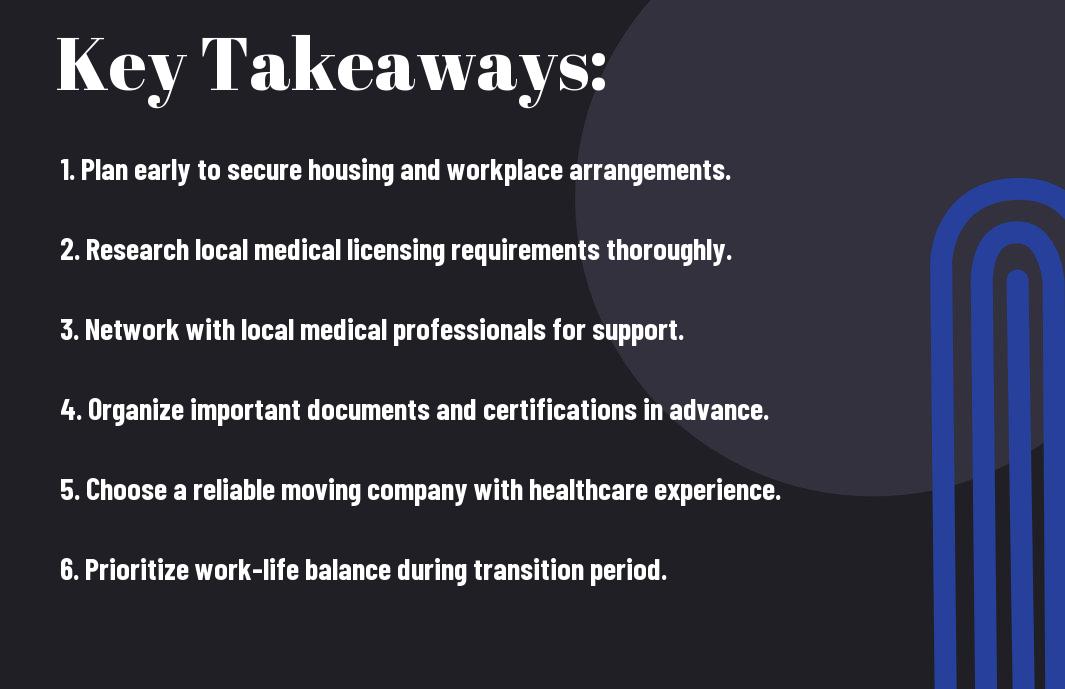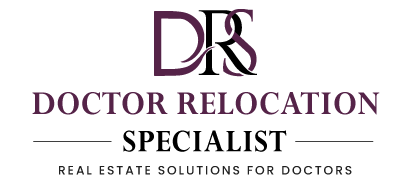Over the course of your medical career, you may find yourself relocating for new opportunities or advancements. This guide provides you with crucial tips to streamline your move, ensuring that you can focus on what truly matters—your profession and patient care. From finding the right housing to understanding the local medical community, these practical steps will help you navigate the complexities of relocation with ease, allowing you to transition smoothly into your new role.

Navigating Licensing and Credentialing Laws
Understanding the intricacies of licensing and credentialing laws can significantly impact your smooth transition into a new location. Each state has unique requirements for medical professionals, so submerging into the specifics ensures you stay compliant while minimizing delays in your transition. Contact the local medical board or a similar authority as early as possible to clarify their processes and timeline for obtaining or transferring your license.
Understanding State-Specific Regulations
Every state enforces distinct licensing criteria, approval processes, and renewal timelines. You must familiarize yourself with these regulations to avoid any unnecessary setbacks in your practice. Some states may require specific examinations, additional training, or even proof of residency, while others streamline the process for out-of-state professionals.
Streamlining the Credentialing Process
Enhancing your credentialing efficiency can make the transition smoother. Gather necessary documentation—like proof of education, board certifications, and work history—prior to your move. Using a checklist helps ensure you meet each requirement without missing key details. Additionally, staying organized with electronic copies can speed up submission processes across various institutions.
Consider utilizing credentialing services that specialize in assisting medical professionals through this labyrinthian process. These services can often expedite applications, connect you with contacts, and help track submission statuses. Working with these experts can significantly reduce the time taken to secure endorsements and privileges at local hospitals or clinics, enabling you to start working sooner and easing the overall transition process.
Strategizing the Financial Aspects of Your Move
Moving to a new location as a medical professional involves careful financial planning. Understanding the costs associated with your move and creating a strategy can ensure that you manage your finances effectively during this transitional period. By preparing a comprehensive plan, you can navigate expenses related to transportation, housing, and other necessary services, making your relocation smoother and less stressful.
Budgeting for Relocation Expenses
Start by detailing all potential relocation costs, including hiring moving services, temporary housing, and travel expenses. Create a budget that encompasses both fixed and variable costs, such as utility deposits or even storage solutions for your belongings. With a well-outlined budget, you’ll gain clarity on what you can afford and where you may need to find savings.
Exploring Reimbursement Options and Tax Deductions
Research available reimbursement options offered by your new employer, as many healthcare organizations provide relocation assistance for their staff. Additionally, keep an eye on potential tax deductions that might apply to your move. Certain expenses, such as those related to job searching and transporting your household goods, may qualify for deductions under IRS guidelines.
For example, if your move meets the IRS’s criteria for a work-related relocation, you could deduct various costs like transportation of your family and personal belongings, as well as lodging while you make the transition. Document all relevant expenses meticulously—receipts and invoices will support your reimbursement requests and tax filings. If eligible, this could lead to significant savings, allowing you to start your new position without financial strain.
Finding Your Ideal Community
Your new community plays a significant role in your overall happiness and success. Look for a neighborhood that offers a balance between professional opportunities and personal interests. Consider the lifestyle you desire, whether it be a vibrant urban center or a quiet suburban retreat, and explore the local culture, recreational activities, and community engagement available in each option. Each aspect contributes to the overall quality of life you can expect to experience during your time there.
Evaluating Proximity to Healthcare Facilities
Assessing how close you are to hospitals, clinics, and specialty medical practices is vital for both your personal and professional life. Being near quality healthcare facilities enhances your ability to deliver optimal patient care, network with other professionals, and access continued education opportunities. Pay attention to the number and types of healthcare institutions in your vicinity and the reputation of their services.
Assessing Quality of Life and Local Resources
Quality of life encompasses more than just access to professional opportunities; it also includes factors like cost of living, education, and recreational activities. Explore public services such as libraries, parks, and community centers, which can enrich your lifestyle. Investigate educational opportunities, from schools to training programs, as well as healthcare services, public transportation, and safety. Areas with diverse dining options, shopping, and entertainment can significantly enhance your experience in a new community.
Evaluating local resources further involves plunging into the unique attributes of each neighborhood. Communities with active social groups and health-focused institutions can offer valuable networking avenues for medical professionals. Understanding how engaged the community is in health initiatives or wellness programs can directly impact your ability to thrive professionally and socially. Access to outdoor spaces, cultural events, and community support systems can help you establish a well-rounded, fulfilling life while easing the transition into your new role and environment.
Organizing a Seamless Transition
A smooth relocation hinges on meticulous planning and organization. Start by addressing each aspect of your move, from housing arrangements to job transitions, ensuring everything aligns with your timeline. Clear communication with employers and real estate agents can help streamline deadlines and minimize stress. With careful attention to detail, your transition can feel less overwhelming and more like a new adventure.
Planning Your Moving Timeline
Create a moving timeline that spans at least two months before your desired moving date. Outline key milestones such as notifying your current employer, scheduling movers, and setting up utilities at your new location. Assign specific dates to each task, ensuring a structured path toward a successful move.
Essential Packing and Logistics Tips
Efficient packing and logistics require an organized approach. Start by categorizing your belongings into importants, keepers, and items to donate or discard. Use high-quality packing materials to protect fragile items, and clearly label each box for easy unpacking. Schedule your moving truck and any necessary help ahead of time to coordinate a smooth process.
- Pack one room at a time to avoid feeling overwhelmed.
- Use bubble wrap and foam for delicate items, while sturdy boxes are important for heavier objects.
- Label boxes with contents and destination rooms.
- Consider using color-coded labels for different rooms.
- Assume that excessive packing will complicate your unpacking phase.
When organizing logistics, ensure you have all vital paperwork for both your current and new location. This includes your job documentation, medical licenses, and health records, all easily accessible during the move. Schedule utility services ahead of time along with internet and cable installations, ensuring comfort upon arrival.
- Research local service providers to have a smooth transition.
- Contact friends or family who can offer assistance or recommendations.
- Track moving expenses to manage your budget effectively.
- Consider temporary housing if necessary, especially if you need time to finalize your new home.
- Assume that unexpected delays might occur and plan accordingly with contingency measures in place.
Building Professional Networks in a New Location
Establishing a strong professional network in your new location can significantly enhance your career and ease your transition. Engaging with fellow medical professionals, attending local conferences, and joining relevant associations can connect you to valuable opportunities and resources. Make an effort to participate actively, share your expertise, and forge relationships that can support your goals and well-being as you settle into your new role.
Engaging with Local Medical Communities
Getting involved with local medical communities can accelerate your integration into a new environment. Attend workshops, seminars, or grand rounds at nearby hospitals and clinics to meet colleagues and learn about the specific healthcare landscape in your area. Volunteering for events or initiatives allows you to showcase your skills while also building camaraderie with local professionals.
Utilizing Online Resources for Networking
The digital landscape offers a wealth of networking opportunities for medical professionals. Platforms like LinkedIn and Doximity allow you to connect with peers, discover job openings, and participate in discussions relevant to your specialty. Additionally, many professional organizations have online forums and social media groups where you can exchange ideas and seek mentorship from experienced practitioners.
Engaging with online networks can enhance your visibility and help you stay current with industry trends. Participating in local virtual meetups or webinars can also introduce you to key influencers in your field, paving the way for potential collaborations or job leads. As a newcomer, sharing your journey and expertise online can encourage others to reach out to you, thereby enriching your network and fostering a sense of belonging in your new community.
Conclusion
Now that you have an array of relocation tips specifically for medical professionals, you’re well-equipped to make your move as smooth as possible. By planning ahead, researching your new area, and utilizing resources tailored to your needs, you can alleviate stress and focus on what truly matters—your career and well-being. Your successful transition into your new role and community starts with thorough organization and proactivity, ensuring you settle in and thrive in your new environment.

